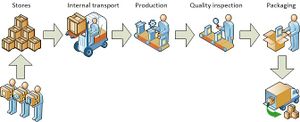Serial production
| Serial production |
|---|
| See also |
Serial production is one of the main types of organization of mass production. It is a technique used in the manufacture of products in series made in the same way. As in mass production, products during the manufacturing process are in constant motion between each production positions.
The main difference between mass production and serial production is the continuity of the work. In the case of mass production manufacturing of products is carried out on a continuous basis, there is no production breaks.
Serial production, however, is characterized by the production of a batch of products after which, production is stopped. It this time it is possible to adapt the manufacturing machines for the production of a new type of product. Also stopping of production in anticipation of another order is commonly used.
Application of serial production
Serial production is used mainly by: footwear and paints producers, in the production of drugs and their ingredients, in bakeries, etc. Bakeries deliver products according only to the ordered quantity, and set up manufacturing process in advance. This allows for more efficient use of working time and equipment needed. After preparing the whole batch ovens are switches off which translates to savings of money.
In the manufacture of paints and inks, managers start the production of colours from bright (e.g. yellow) and next each successive batch of colours are slightly darker (from orange to black). Production carried out in such a way allows to decrease costs.
References
- Boyaci, T., & Gallego, G. (2001). Serial production/distribution systems under service constraints. Manufacturing & Service Operations Management, 3(1), 43-50.
- Bracht van, E. (1995, October). Performance analysis of a serial production line with machine breakdowns. In Emerging Technologies and Factory Automation, 1995. ETFA'95, Proceedings., 1995 INRIA/IEEE Symposium on (Vol. 3, p. 417-424). IEEE.
- Gong, L., de Kok, T., & Ding, J. (1994). Optimal leadtimes planning in a serial production system. Management Science, 40(5), 629-632.
- Yano, C. A. (1987). Setting planned leadtimes in serial production systems with tardiness costs. Management science, 33(1), 95-106.
- Mass Production @ Wikipedia.
